How to find low-competition keywords
Let’s face it. Finding the right keywords to target can be tricky these days. Especially for new websites, focusing only on broad keywords might not be the best way to get noticed. Instead, focusing on keywords with less competition can give you a leg up and help you build a stronger online presence.
In this article, we’ll explore the ins and outs of low-competition keywords, their significance in SEO and Google Ads, and, most importantly, how to find, secure, and use them in your SEO strategy.
-
Low-competition keywords offer an opportunity for websites, especially new or smaller ones, to rank well on search engines. Because these keywords have fewer competitors vying for top positions, they can be easier to rank for and still bring valuable traffic to your site.
-
You can identify low-competition keywords by first using dedicated tools like SE Ranking’s Keyword Research Tool to generate a seed list. Then, expand this list with related keywords, long-tail variations, and more specific terms that users are searching for to find content like yours. Finally, filter your options by difficulty score to target keywords that attract the ideal audience for your content.
-
Low keyword competition can help outrank competitors in organic search and save on advertising costs, but targeting should also consider factors like content quality and search intent.
-
When analyzing keywords, pay particular attention to the domain trust (DT) of both your website and your competitors. In fact, high-DT websites often rank better for both competitive and low-competition keywords compared to websites with lower DT. However, even low-DT websites can outrank high-DT ones with high-quality and up-to-date content.
What are low-competition keywords?
As the name suggests, low-competition keywords are search terms that have a relatively small competition level compared to other keywords, which makes them a great opportunity for both SEO purposes and Google Ads campaigns. Since it’s way easier to rank for low-competition keywords in SERPs, you can hit the traffic jackpot by targeting them.
Despite the common belief that low-competition keywords = long-tail keywords, this is not always true. While short-tail keywords are typically very competitive, you can still find fairly reachable short- and middle-tail keywords for your website.
However, don’t discount the power of long-tail keywords altogether.
Even though long-tail keywords often appear to have ‘low search volume’, they can still be a great source of traffic. Instead of focusing on a singular high-volume keyword, you can target a bunch of smaller volume keywords that can get you the same amount of traffic. In fact, the traffic generated by five good niche keywords could bring the traffic you’d get if you were to rank for a generic high-volume keyword. This is especially true for Google Ads.
Besides, long-tail keywords tend to be more specific and niche-oriented, so content created around them has the potential to attract a target audience that is more precisely defined and way further down the buying cycle.
On the other hand, short-tail, high-volume keywords may also have a low competition level. This typically happens when a keyword is not targeted strategically by other websites. This often happens in the following cases:
- Niche targeting: These terms may not match the products or services offered by others.
- Seasonality: Think of a high-volume keyword that is less competitive at off-peak times.
- Emerging trends: Keywords related to emerging or new trends may not have gained much attention yet.
How to find low-competition keywords
Now that you understand what are low-competition keywords and how they can be helpful, let’s dive into the step-by-step process of finding them.
Step 1. Build your initial keyword list
Begin by identifying seed keywords that correspond to the core purpose of your business or content. These key terms will act as your guide, helping you set the stage for more targeted and refined search terms when conducting any future keyword research.
Take time to think about any broad themes associated with the products/services your business offers. For instance, if you’re a fitness company that sells sports equipment, the most relevant seed keywords for your business might be “fitness equipment,“ “gym gear,“ “exercise machines,“ “weightlifting gear,“ “home workout tools,” and “fitness accessories.” These seed keywords will serve as the basis from which to expand upon when creating a list of keywords that people might use when looking for fitness products.
Now, there’s no need to collect a large number of seed keywords. If selected carefully, a few main search terms can form the basis for a comprehensive list of keywords that have the potential to attract the right audience. This is where you’ll need to prioritize quality over quantity.
Once your list of seed keywords for SEO is ready, you can use SE Ranking’s Keyword Tool to build a comprehensive list of search terms. This tool not only provides a list of similar, related, and low search volume keyword options, but also allows you to analyze each search term using a set of essential SEO metrics, including monthly search volume, CPC, competition, and difficulty.
Let’s see how this tool analyzes queries in action using the “portable gym equipment” keyword.

As you can see in the screenshot above, “portable gym equipment” has a low difficulty score of 15 and a relatively high search volume of 210 in the US. This indicates that it won’t take much effort to target it with your content and generate traffic.
But let’s not stop here.
Let’s identify even more valuable opportunities based on queries like this. Simply navigate to the Keyword Suggestions section and take a look at the list of Similar, Related, Question-Based, and Low Search Volume keywords.
Within the Similar section, you’ll find alternative search queries bearing semantic resemblance to your particular keyword (e.g., best portable home gym equipment). In the Related section, there are keywords that share common pages ranking among the top 100 search results on Google. Take a look here at the Relevance column, as it represents essential data on how well the keyword matches the analyzed term. The higher this metric, the higher the keyword’s relevance.
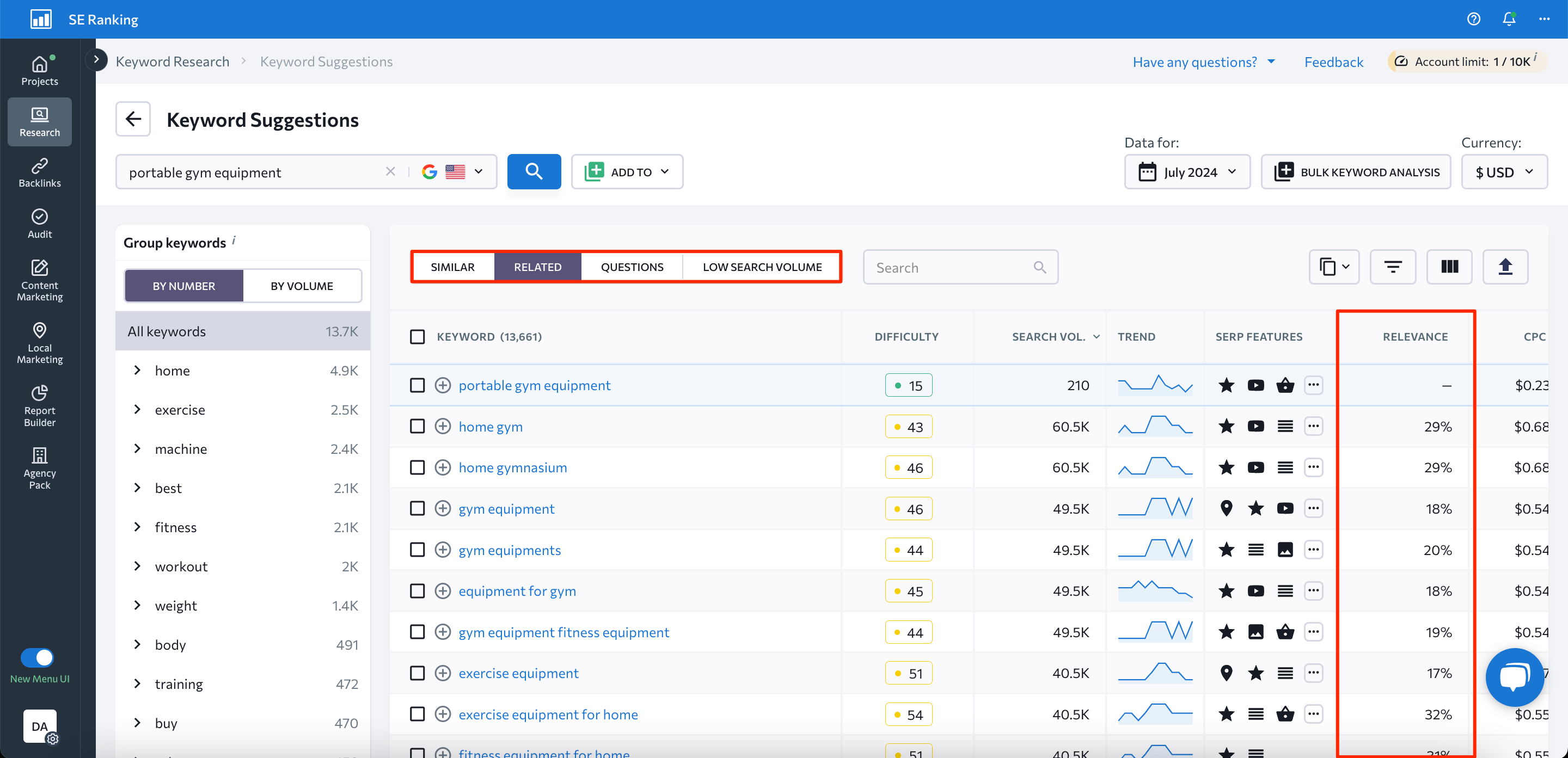
What’s more, this tool gives you the opportunity to perform bulk keyword analysis. Let’s say you’ve come up with a list of dozens or even hundreds of search terms during your initial research and want to evaluate their SEO performance. In this scenario, you can import them through .TXT or .CSV files, or manually input them. In a matter of minutes, the tool will analyze the search queries and deliver a comprehensive report brimming with valuable SEO data on all of your keywords.
Step 2. Expand the list
Now you have the initial list of keywords at your fingertips, but there’s still more work to be done. It’s time to expand this list with related keywords, long-tail variations, and more specific search terms that people are using to find content similar to yours.
To identify more easy keywords to rank for, you’ll need to explore your competitors’ websites and examine the keywords they are targeting. This can provide valuable insights into untapped opportunities within your niche.
To make things easier, you can use SE Ranking’s Competitor Website Analysis Tool. This tool helps you get a bird’s-eye view of your competitors’ traffic, backlinks, ad strategies, and most importantly, the keywords they use to attract and convert leads into potential customers.
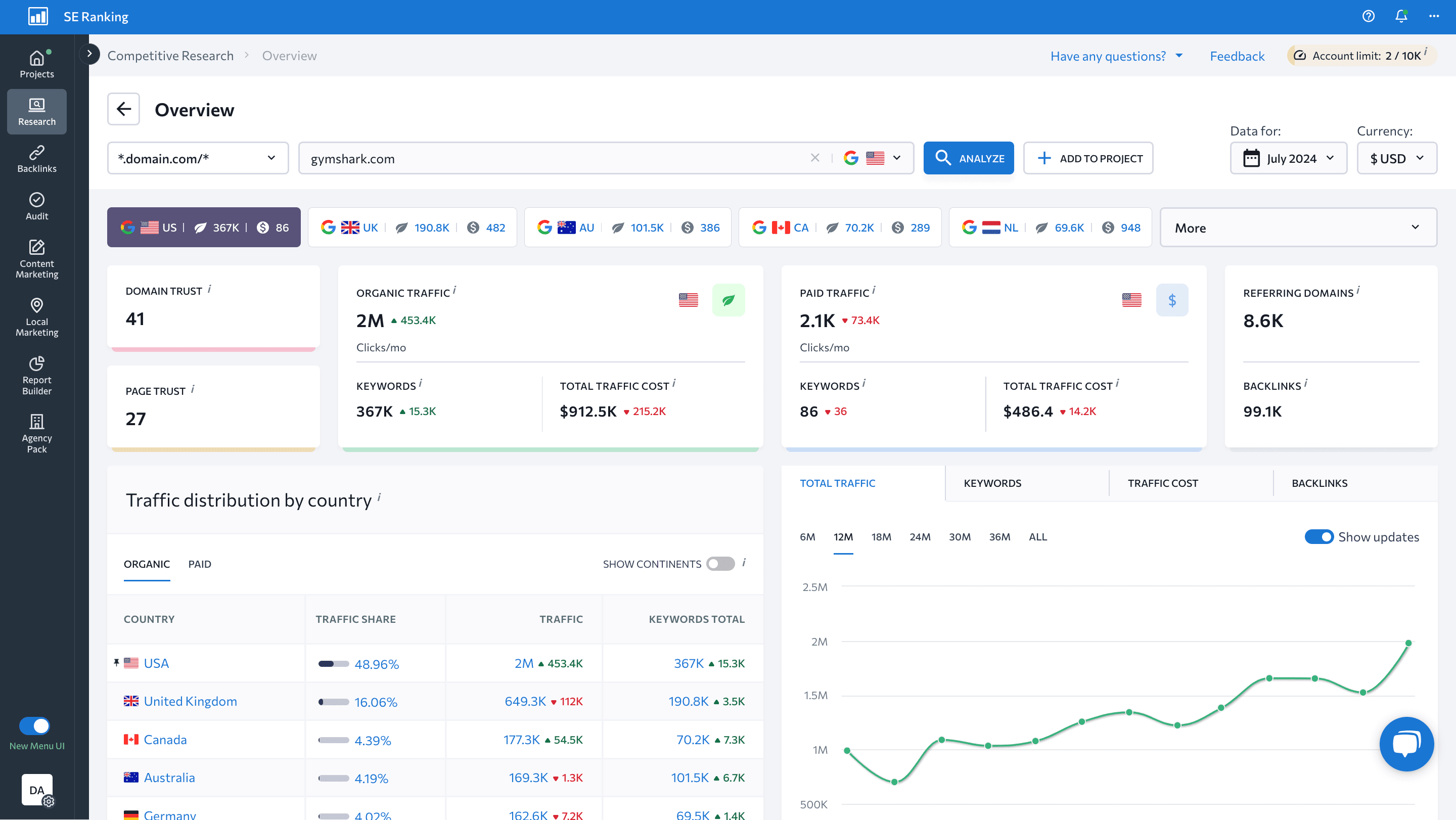
This tool’s Competitor Comparison section goes beyond competitor analysis. It acts as a keyword gap tool, letting you compare your website’s keywords to any two other domains to determine any keyword gaps or overlaps.
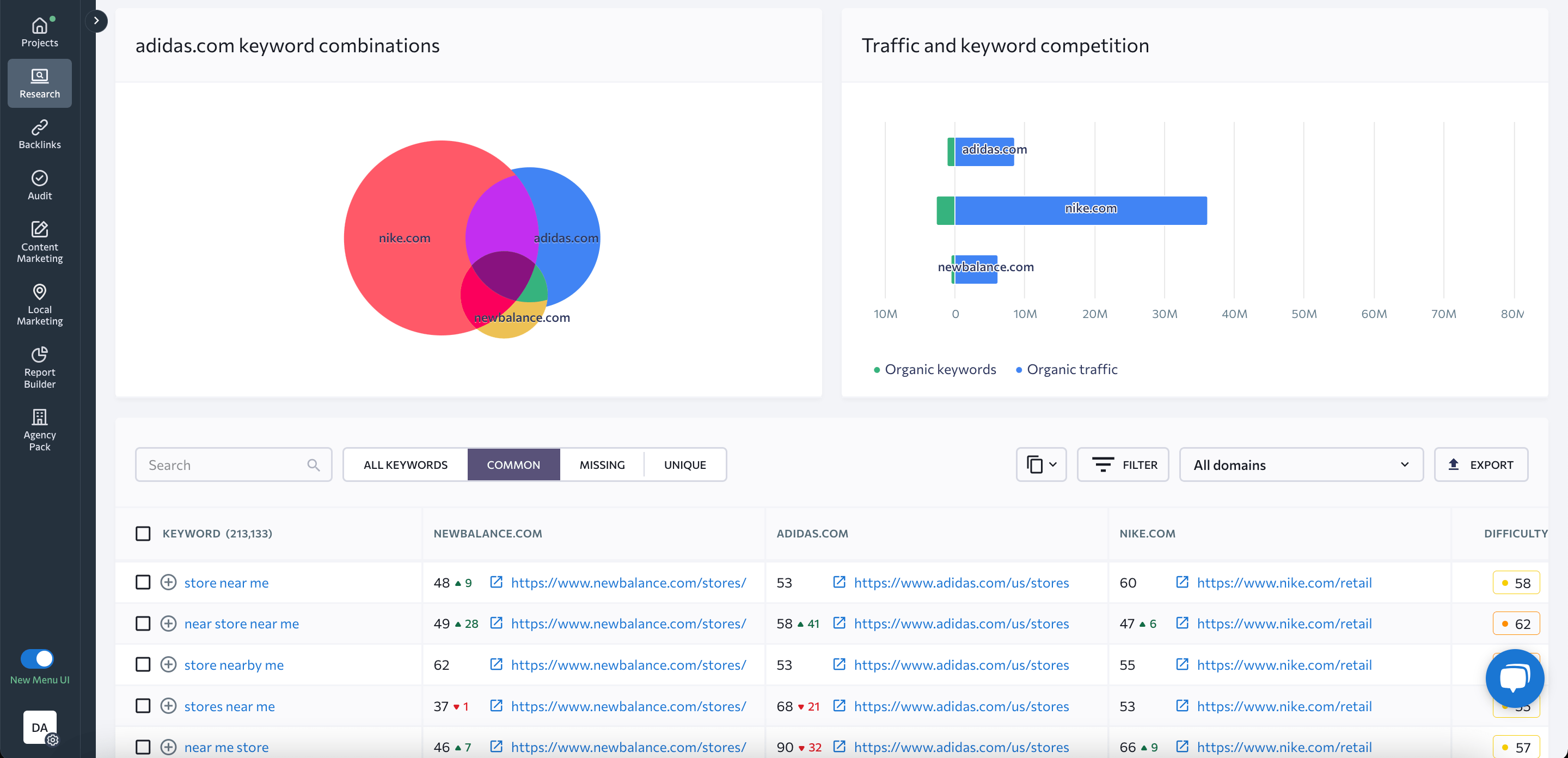
You can compare keywords between domains in any way you want: domain 1 vs domain 2, domain 1 vs domain 3, or domain 2 vs domain 3. Also, this tool allows you to discover search terms that are unique to each domain.
Besides, to find valuable keyword opportunities, pay particular attention to the Competitors’ New Keywords block within our Insights feature. It provides essential info on the search terms your direct competitors have started ranking for in the past 30 days.
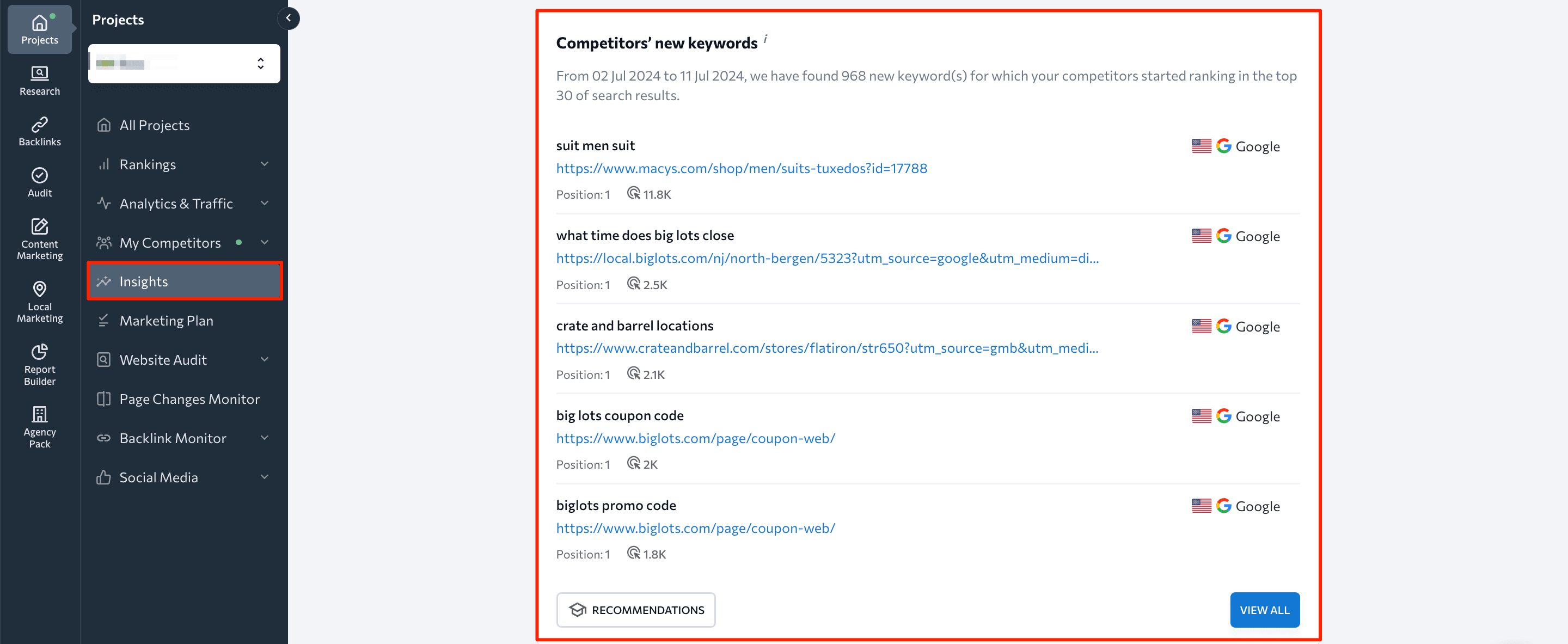
For each new keyword, the report provides a wealth of data to help you decide your next move. This includes search volume, keyword difficulty, SERP position, and even a traffic forecast.
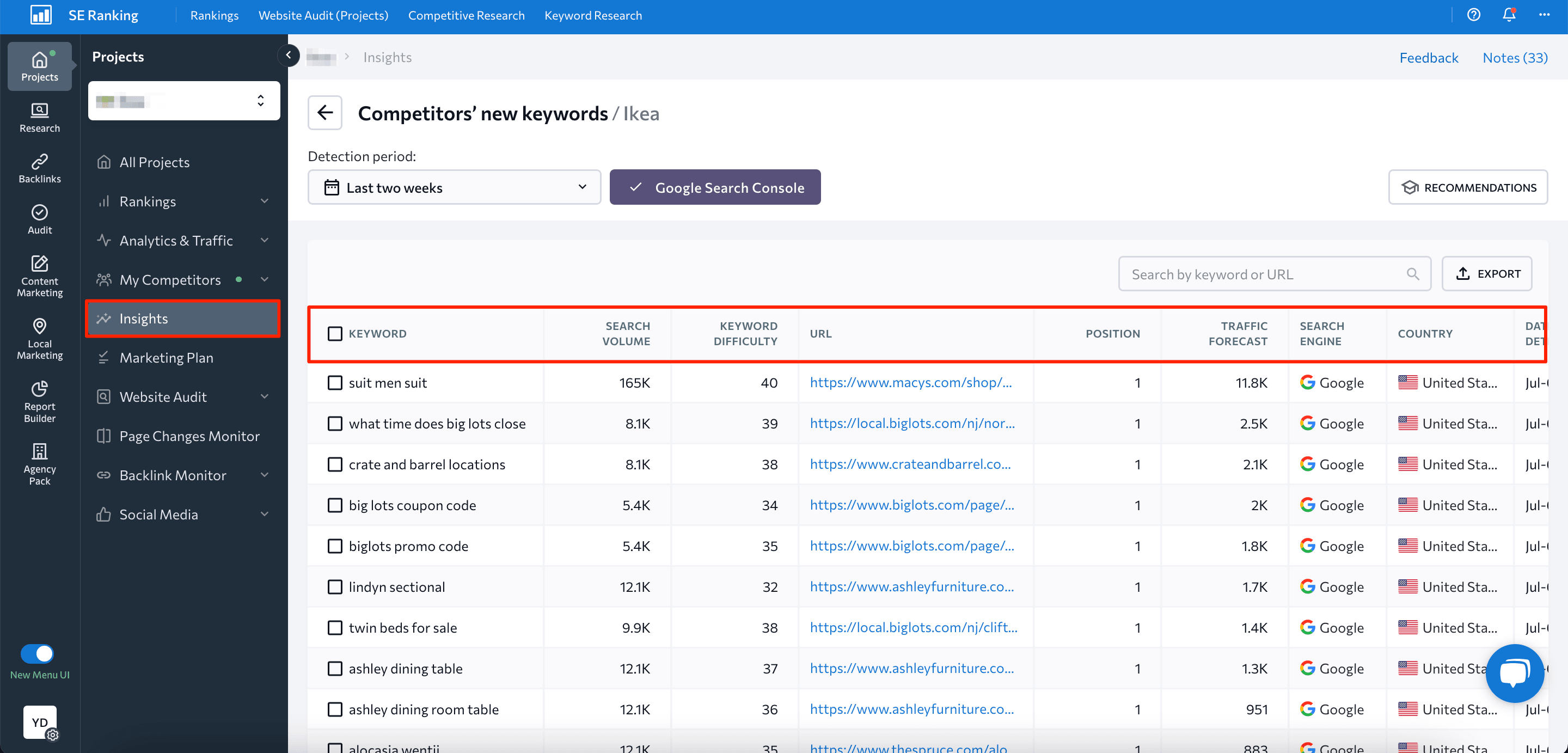
Keywords with a difficulty score of 30 or below are considered the easiest to rank for. Focus on incorporating these keywords into your existing content or creating new content specifically optimized for them.
As a bonus, we recommend you regularly monitor the data within Insights’ Keywords for Which Impressions or Clicks Have Significantly Increased block. This section showcases keywords experiencing a recent growth in SERPs. Even if they’re not traditionally low-competition, their increasing online visibility suggests they have the potential to boost your ranking and attract high-quality traffic.
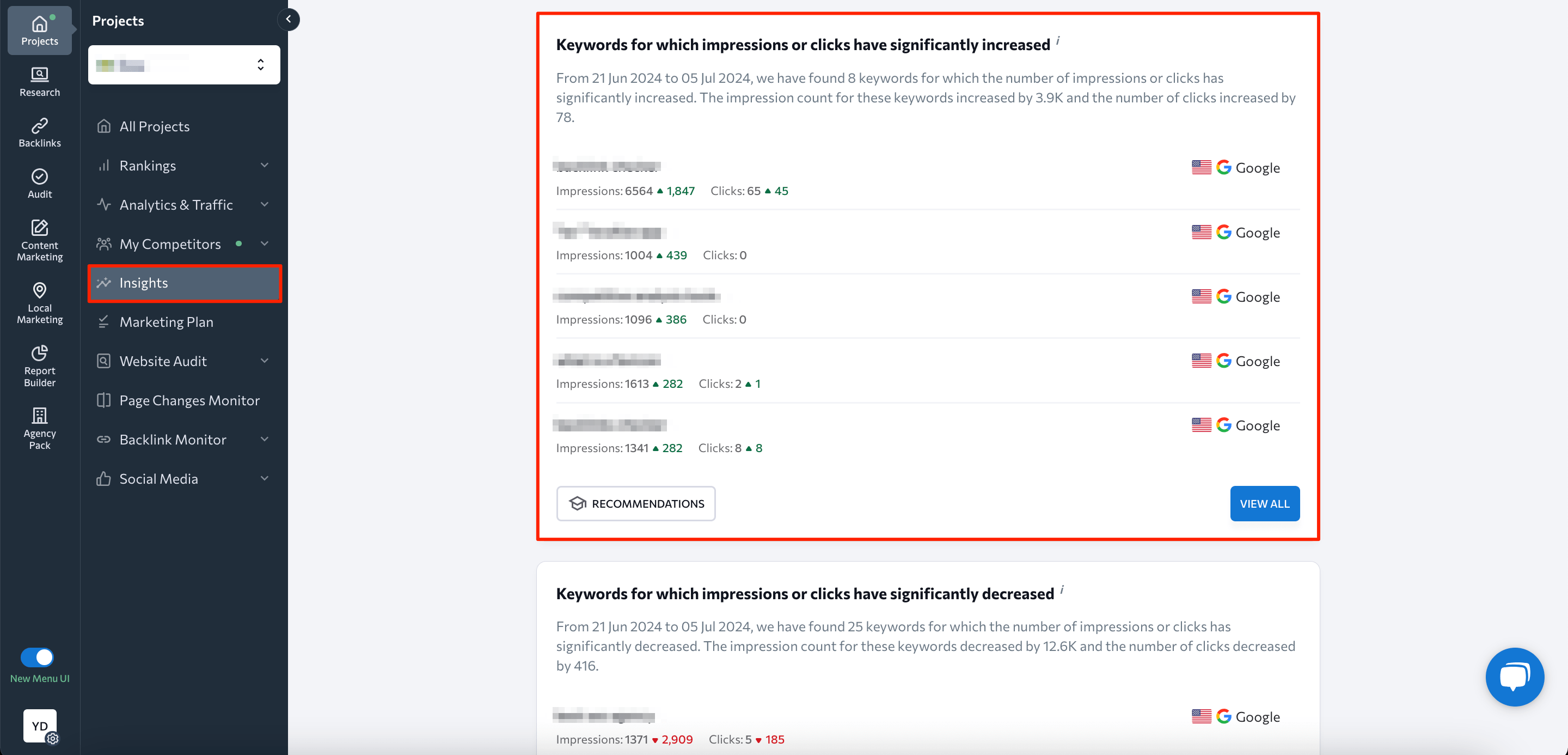
Simply connect Google Search Console to your project, and we’ll generate a comprehensive report revealing key information on keywords with surging clicks and impressions over the past month. This will make it easier for you to decide which ones to target in your content.
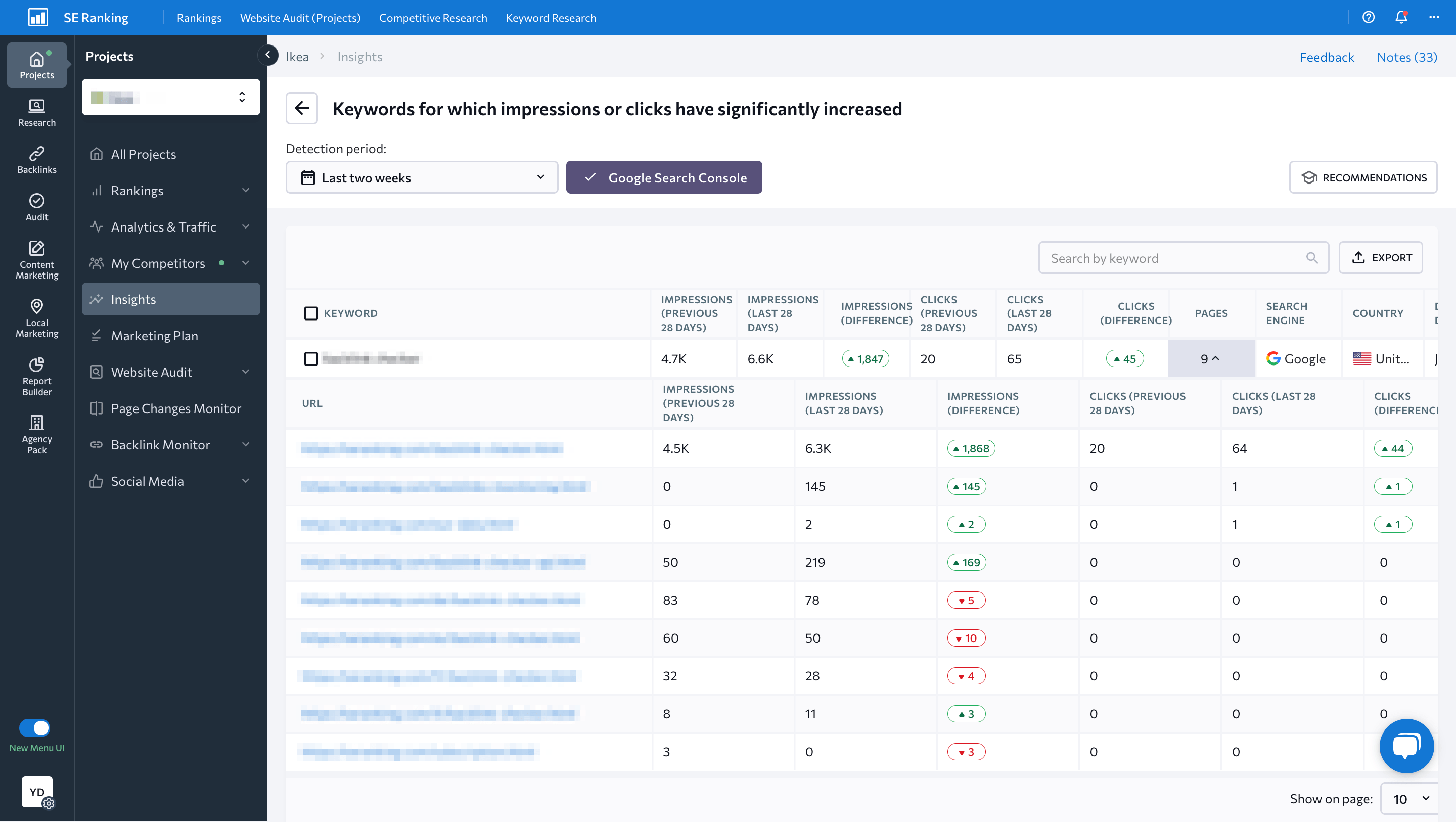
Step 3. Filter for low ‘difficulty’ keywords
The last important step in finding low-competition opportunities is applying filters to narrow down your search. Identifying keywords with a lower difficulty score means you are more likely to attract the right visitors who will benefit from your content and offerings.
Whether you use SE Ranking’s Competitive Research Tool or Keyword Research Tool, you can easily filter lists of keywords within a few clicks. Just click on the Filters button, then tailor the difficulty score to your liking by selecting a specific range, ideally aiming for low-competition keywords within the 0-10 score range. Your keyword list might look like this as a result:
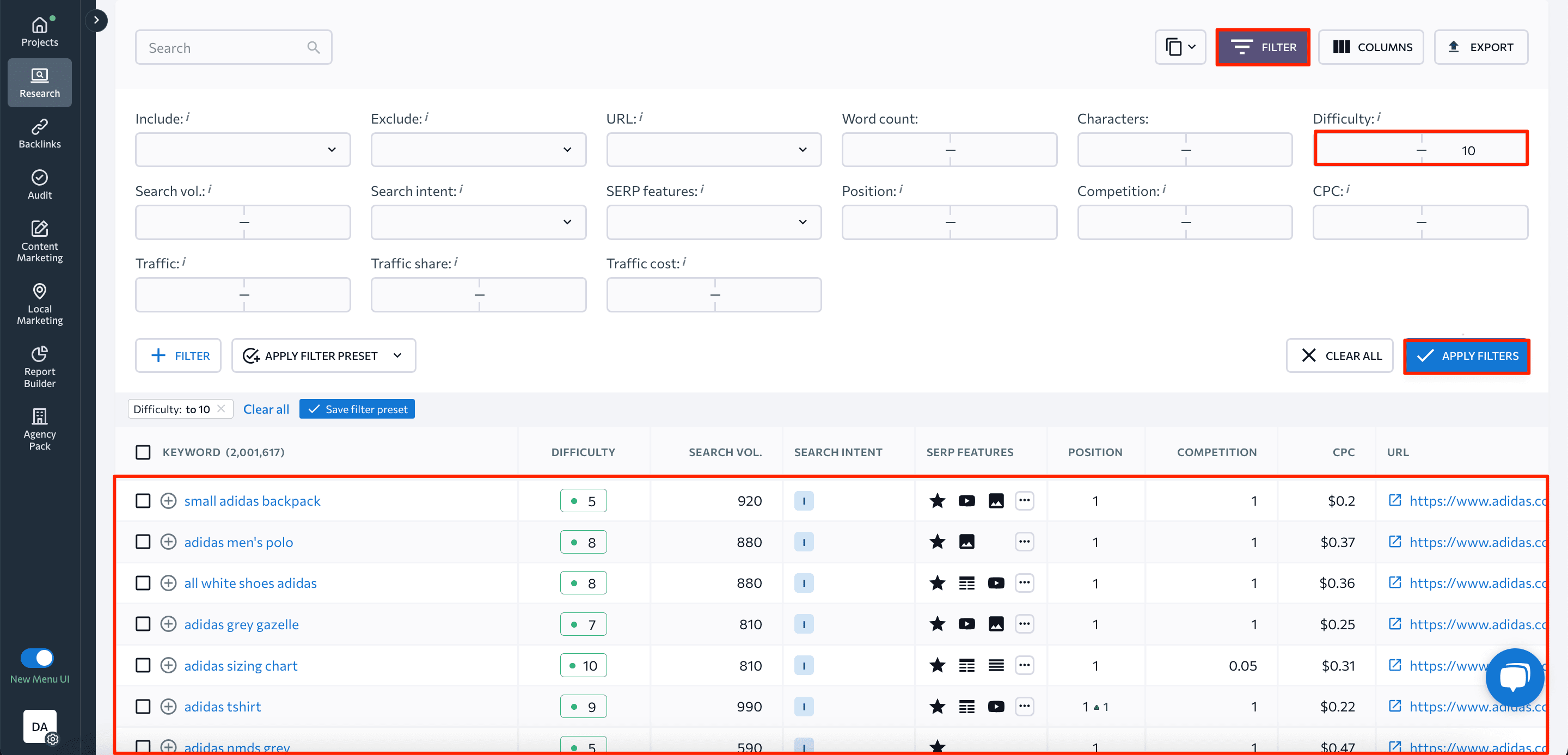
To narrow down your list, you can use a mix of parameters to find the right keywords. For example, you can filter keywords by search intent (e.g., transactional), or by the minimum number of words in the phrase.
To illustrate this example, you can identify long-tail keywords by applying a filter to search terms that consist of three or more words. You can also filter keywords by difficulty score (e.g., no more than 30), and high search volume (e.g., starting from 100 monthly searches).

Understanding keyword competition
Now that you know how to find low-competition keywords, let’s move on to keyword competition metrics. We’ll determine how the competition metric correlates with other metrics, and look into how it is measured by different tools.
Keyword difficulty vs. competition
Let’s first consider that the terms we use here are specific to our own tools, but they may have some semantic overlap with alternative tools in other contexts. Now that we know that, let’s take a deep look at the differences between keyword difficulty and keyword competition.
Long story short, keyword difficulty can be defined as a measure of how difficult it would be to rank for a given keyword in organic search. Keyword competition, on the other hand, reflects the same data but for paid results.
The difficulty score is usually used in SEO and is mostly determined by the authority level of the websites that are targeting this particular search query as well as their backlink profile. A low keyword difficulty usually indicates that it will be easier to get into the top positions of SERPs when targeting certain keywords.
Still, keep in mind that different tools often yield different results for keyword difficulty. This is because they operate based on different algorithms.
Here at SE Ranking, we calculate the difficulty score based on the top 10 search results for a given query, considering the quality of domains and their backlink profiles. As keyword difficulty rises, so does the amount of SEO efforts needed for optimization.
Using our unique algorithms, we provide a keyword difficulty scale ranging from 0 to 100:
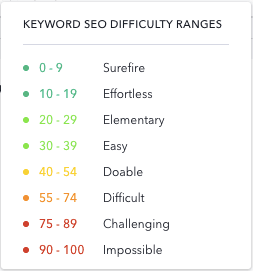
On a related note, the keyword competition metric typically shows the level of competition in Google Ads for a specific keyword. This metric helps advertisers gauge how challenging it would be to bid on a particular search term.
We source competition data directly from Google Ads and categorize it into three main blocks, ranging from low to high:
- Low competition: Score of 0 to 0.3
- Average competition: Score of 0.3 to 0.7
- High competition: Score of 0.7 to 1
When Google lacks sufficient data for a keyword, SE Ranking displays a dash (-) to indicate the absence of information.
The same categorization principle is used in Google Keyword Planner, with competition scores ranging from 0 to 100. To calculate this value, Google divides the number of filled ad slots by the total number of ad slots available.
High keyword competition results in higher bids and higher CPC, while low keyword competition can often help you save on your campaign budget. To prevent fruitless spending, consider checking keyword competition before running your ads.
Keyword competition and search intent
Even if a keyword has low competition, targeting it just because it corresponds to certain numbers is not the best idea. In fact, after conducting keyword research, your next step should be to create high-quality content around the identified search terms. What’s even more important is aligning it with the intent of your target audience.
For example, you can target navigational keywords related to other brands, pushing your content up to the top 5 of organic search results. But searchers will unlikely click on your results if their primary intent is to visit this particular brand’s website.
To ensure you’re headed in the right direction and select the right keywords for your website type, pay special attention to the search intent of potential keyword opportunities. One way to identify the search intent type behind search queries is by looking at their modifiers:
- Informational: “What is…?”, “How to…?”, “Meaning of…?”
- Navigational: “Official website of…?”, “Location of…?”
- Transactional: “Buy…?”, “Deals on…?”, “Price of…?”
- Commercial: “Best…?”, “Review of…?”, “Compare…?”
- Local: “Near me”, “Local…”, “City name + service/business”
You might also have a list of dozens or even hundreds of keywords, so going through each of them would be too inconvenient and time-consuming. To streamline this process, you can refine your search by filtering keywords that match your search intent.
To illustrate this, when using SE Ranking’s Keyword or Competitive Research Tool, you can go to Filters and select one or more user intents by pinpointing them.
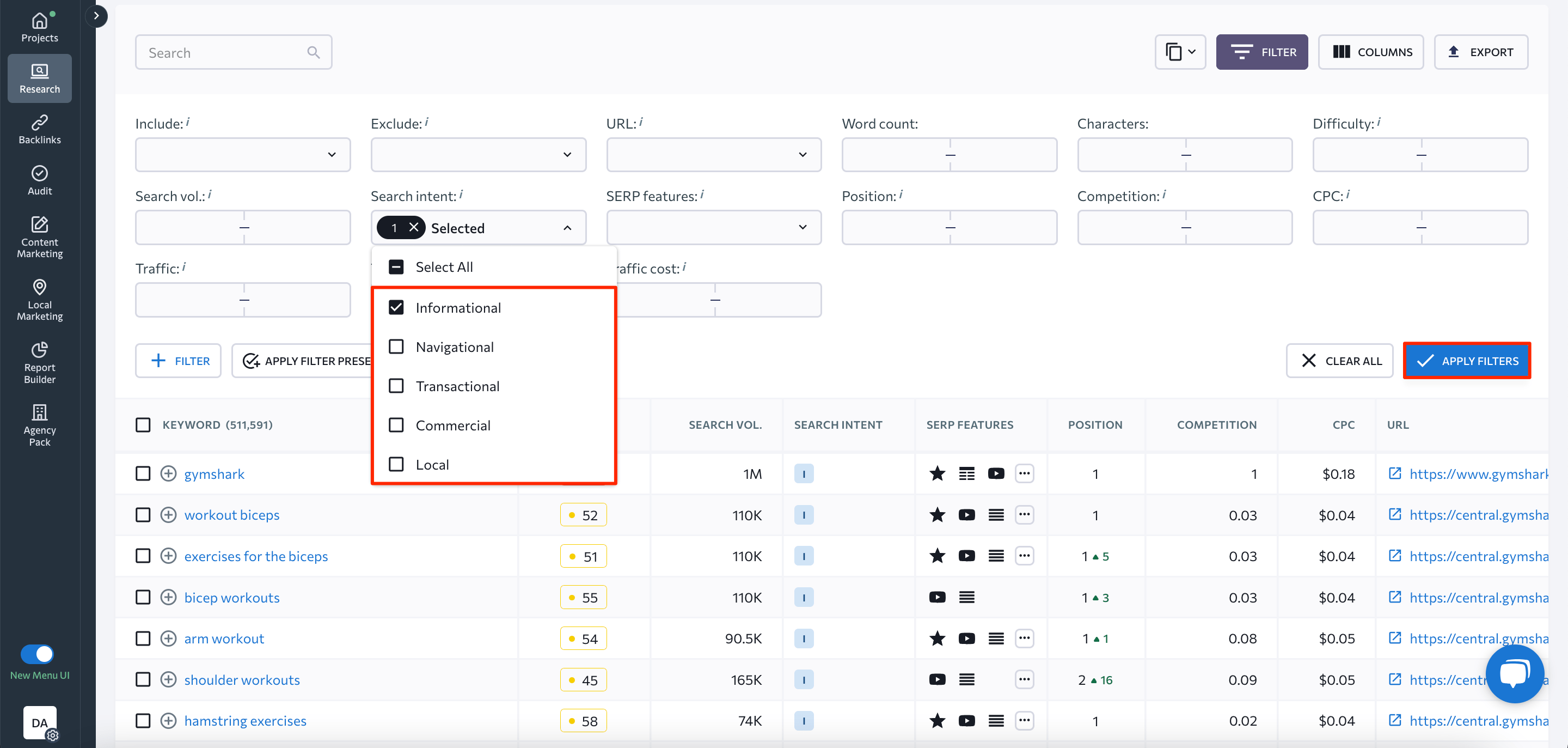
And there you have it—a keyword list with terms that are perfectly aligned with the desired search intent.
There’s also an alternative option. You can identify keywords with a specific search intent by filtering queries using the phrase match method. So if you want to find informational keywords, click on the Filters button and input the “how to” keyword into the Include field. This will help you discover keywords that match a specific search intent using the above-mentioned modifiers.
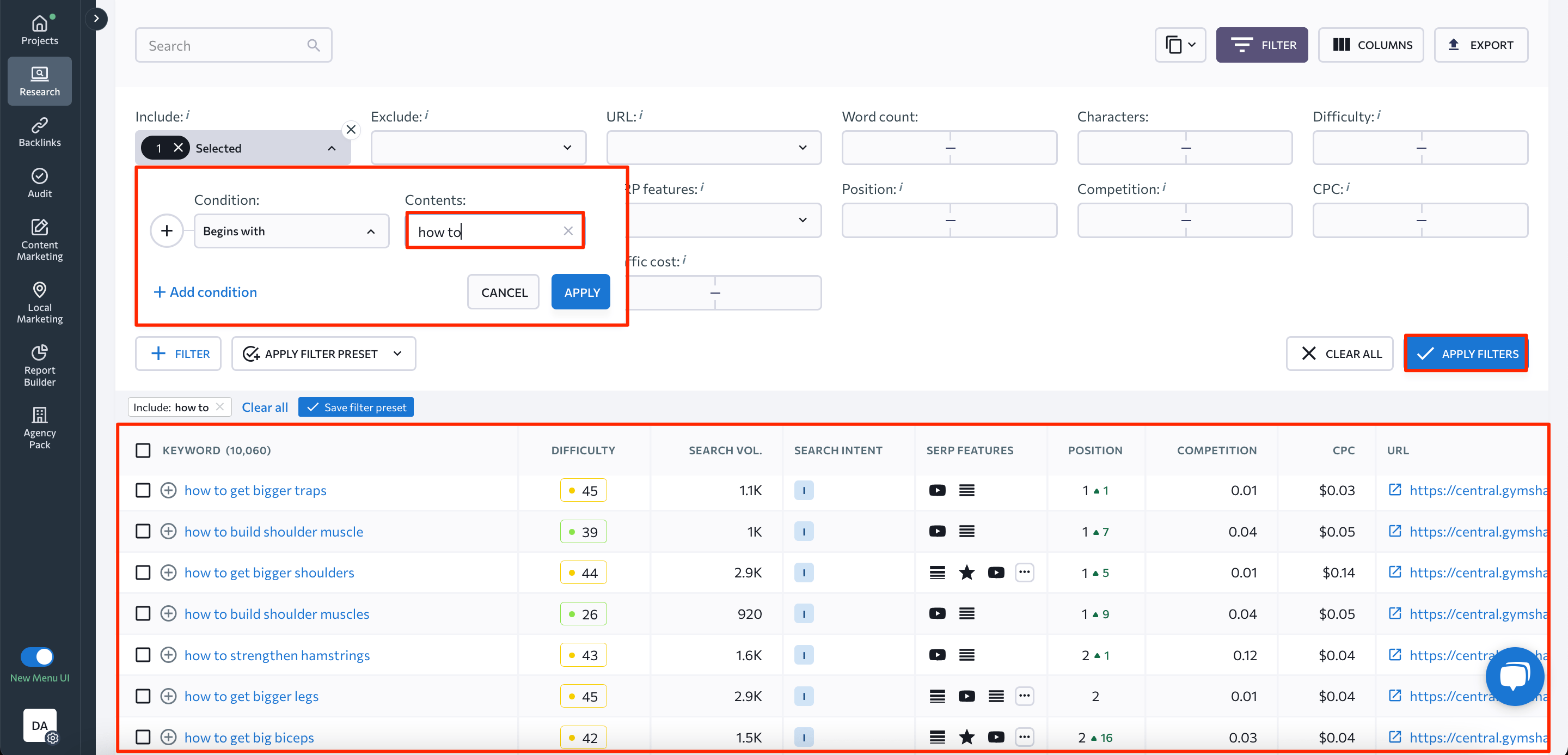
Keyword competition and domain trust
When analyzing potential keyword opportunities for your website, you need to know the relationship between domain trust and keyword difficulty/competition. Domain trust measures how strong your backlink profile is. And while SE Ranking’s keyword difficulty metric largely relies on the backlink analysis of URLs within a particular SERP, the domain trust metric is based on the overall assessment of a specific domain in terms of its referring domains and their quality.
This might put you in a situation where a keyword initially appears to have low difficulty, but a more in-depth analysis using our SERP Checker reveals a different picture; each domain appearing in the SERP has a particularly high level of domain trust. This implies that the keyword won’t be able to get into the top 10 results.
Typically, websites with a high DT are way more likely to secure rankings for both highly competitive and less competitive keywords compared to new or smaller websites. Let’s say you’re launching a blog that provides valuable information in the technology sector. You’ve created high-quality content around low-competition keywords and expect to get a boom of organic search traffic, but then you notice that TechCrunch has published an article using the same search terms. Even if TechCrunch builds zero backlinks to this page, it will still outrank you. Why? Domain trust and having a website with a strong overall backlink profile is the answer.
But it’s still useful to target low-competition keywords even if you have a lower DT than bigger online players. Since there are over 200 factors that can affect SERP performance, even websites with lower DT can easily outrank competitors with a higher score.
The beauty of low-competition keywords is that you can often outrank big brands with robust websites simply by offering impeccably optimized, higher-quality content.
And if you have no idea what your DT is, you can use our Domain Trust Checker to check your score.
Closing thoughts
Low-competition keywords are indispensable for SEO and Google Ads campaigns. But if you want to find the most profitable options that align with your marketing goals, you’ll have to invest some time into advanced keyword research. Rest assured, this process will pay off in the long run.
Now, building a list of low-competition keywords is only the first step to attracting the right audience. Your next task is to produce high-quality content that resonates with the needs of your audience, which is another story entirely.

